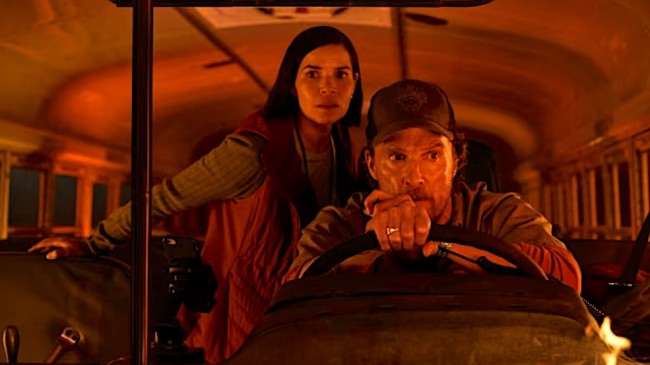A Conversation with America Ferrera, Jamie Lee Curtis, Jason Blum, Kevin McKay, and Mary Ludwig on “The Lost Bus”

The Lost Bus is a gripping story based on the true story of Kevin McKay, a school bus driver, and Mary Ludwig, a teacher, who heroically saved the lives of 22 children during a catastrophic wildfire in Paradise, California in 2018. The film portrays their extraordinary courage as they navigated the fiery chaos, putting their lives on the line to ensure the emotional and physical safety of the school children in their care.
In this powerful film adaptation of the novel Paradise: One Town’s Struggle to Survive an American Wildfire by Lizzie Johnson, The Lost Bus tells the riveting story of a struggling school bus driver Kevin McKay (Matthew McConaughey) with a strained relationship with his estranged son and ex-wife, and school teacher Mary Ludwig is accurately brought to life by America Ferrera,
In this discussion with actress America Ferrera, producers Jamie Lee Curtis and Jason Blum and real-life subjects Kevin McKay and Mary Ludwig, they detail their journey into bringing this riveting story to the screen.
Jamie Lee Curtis: This is indeed a thrilling full-circle moment for me. The genesis of this story was quite simple, but powerful. While I was in Idaho, I came across a review of Lizzie Johnson’s book, Paradise in the Washington Post. The review painted a vivid portrait of the devastation from a catastrophic fire and, notably, highlighted the remarkable story of Kevin and Mary — a school bus driver and a teacher who saved the lives of 22 children. I immediately thought, “This must be a movie!” But, at that point, I didn’t take any immediate action.
The next day, as fate would have it, I was again driving and I heard Lizzie Johnson being interviewed on NPR about her book by Scott Simon. I was so moved that I pulled my car over to the side of the road and called Jason Blum on a Sunday. We had just entered a new production deal together and I was excited to pitch this idea to him. I shared the Washington Post article with him and the NPR segment, passionately insisting that we needed to turn this harrowing story into a film — it could become one of the most meaningful projects either of us would ever undertake within this industry.
Jason Blum: Receiving that unexpected call on a Sunday from Jamie was quite the surprise! At that point, I hadn’t anticipated such a fervent pitch. We had just begun our vanity deal, which typically means you’re supposed to at least enter ideas into development. But I was doubtful about how we could get this film made — they’re big decisions to make. Still, Jamie’s passion for the story broke through my initial skepticism, and I recognized that this narrative was undeniably compelling. As a producer, I knew it had the potential to translate beautifully to the screen.
After that call, I took some time to reflect on everything Jamie shared and called her back the very next day. Jamie mentioned the critical need to secure Lizzie Johnson’s book rights. So, I set out to find Lizzie’s agents and get in touch with her. It was vital for bringing some legitimacy to our endeavor. We also reached out to three screenwriters, looking for someone who could capture the essence of the story.
Jamie Lee Curtis: When I reached Brad Englesby, I was ecstatic — he related to the story deeply and agreed to write it on spec. That was a game-changer because having someone so invested in the material from the get-go meant we could push this project forward much more rapidly than anticipated. If he had demanded a fee, a screenwriting fee up front, I don’t know if we would have been able to make the movie.
Jason Blum: We always think that executives or the financiers choose the movies that get made. They choose some movies that get made. But there are some movies that artists choose to make and they’re forced to say yes. And this is one of those movies.
There was no way to make this movie inexpensively, so there was a very small list of people who would unlock the financing, and Matthew McConaughey was on that list.
Jamie Lee Curtis: I had two names for a director. Ang Lee and Paul Greengrass. Go big or go home! Ang Lee is a great filmmaker and really tells the American story well. And I thought he would do great with this story. And Paul Greengrass, who is arguably the best action filmmaker working.
So Matthew gets on the Zoom with Paul and I. He says, “Paul, I loved your movies, but I just want you guys to know, I don’t want to waste your time. There’s not a chance in hell I’m doing this movie.”
Jason Blum: And Paul, because he’s wiser and has more experience in this situation than I do, just started talking. And 90 minutes later, Matthew was more in than out.
America Ferrera: Paul and Matthew were attached and it felt like a Christmas gift to be asked to be a part of this creative group.
But obviously, it’s always about the script and the character and whether or not there’s something in there that feels rich and worthy of exploring. Every hero I’ve ever met in my life is an everyday hero – a neighbor, a friend’s parent, a teacher, a grownup who stopped to care about me, somebody who wasn’t their child. I feel like my life has primed me to believe that real heroes are amongst us and aren’t often the people we look to to be heroes, but are the people left and right of us.
So when I read Kevin and Mary’s story in the script, it felt like these are the people that we should be celebrating. These are the people who at the end of the day risk their own lives and everything at stake to take care of other people’s children.
And to know that this was going to be in the hands of Paul Greengrass, who we all know is a master, to know that the real human character journey at the center of it was not going to get lost because Paul never loses it in the midst of the action, felt like a dream come true as an actor.
I was so lucky to get to speak to Mary for hours. She got on Zoom with me and she answered every single question I asked her. She was so open and generous in sharing her deepest, most personal connections to this story, what it means to her and how it put into context her past and how it impacts her future and her present.
Paul was very clear at the outset that we weren’t making a documentary or a biopic. We were really telling a narrative story inspired by the heroic acts of real life people and that we were going to shape a character.
Jamie Lee Curtis: We were talking about how this film was cathartic for her because of her fire story. We all have a fire story. And the gem here is that there’s some fire, some moment in this film that we all as human beings are in touch with. And that’s beautiful.
Mary Ludwig: It’s truly moving to hear how everything came together. For Kevin and me, it’s still surreal that our experiences are transforming into a film. When you’re in the midst of a crisis, you never really think about it as becoming the subject of a film — it’s just life as we know it. But now, seeing this monumental event portrayed on screen feels incredibly rewarding.
I feel this film profoundly captures the quiet fear we all felt that day the strength that we had to pull from. And I think for Paradise, it was the darkest day for us, but one of our finest days where we all came together and leaned on each other.
I felt like a soldier. I know we’ve talked trying to normalize the trip to make it feel like we’re going here and being really positive. I just really realized how closely those children were watching every expression every action that we were doing. So the goal was to keep their spirits up and stay strong. My faith carried me through.
Kevin McKay: It’s incredible to think about how our lives changed that day. There were elements of crisis, fear, and courage that unfolded in those moments, and it’s humbling to see them recognized. When Jamie reached out to Jason to adapt our story, I felt a deep sense of gratitude. We often perceive heroes as larger-than-life figures, but the truth is that they can be ordinary people who step up in extraordinary ways.
Jamie Lee Curtis: That’s the beauty of this story! It’s not about staggering heroism; it’s about the subtle, yet impactful choices that ordinary people make during times of chaos. Our aim was to capture the reality of Kevin and Mary’s actions and to honor the profound instinct and compassion they showed in a crisis.
Jason Blum: From the onset, we recognized the necessity of staying true to the real experiences. Strong collaboration with Kevin and Mary was paramount; we wanted them to be part of our journey. They shared their stories in depth, helping us understand the emotional stakes and the intricate details of their experiences. It was essential for us to not just dramatize the events, but to convey the underlying emotions that came with those moments.
Mary Ludwig: Being actively involved in this process made a profound impact. We had numerous conversations with the team about the script and how we wanted to portray our experiences. It was vital to ensure that our story was told with respect and accuracy, and that input from Kevin and me was highly valued throughout the filmmaking process.
Kevin McKay: An authentic portrayal of our lived experiences was crucial. Engaging with those who lived through the events adds profound depth — not only for the audience but for us as well. It’s been therapeutic to witness our experiences brought to life in such an artful manner.
Jamie Lee Curtis: The relationships we forged during this project were invaluable. The collaborative energy among the cast and crew kept everyone motivated. We were collectively dedicated to honoring the strength of the real heroes.
America Ferrera: That collective energy is essential in making art! Looking back, were there any particularly challenging moments during production that stood out for any of you?
Jason Blum: There were many challenges! One that stands out was capturing the intensity of the fire scene while remaining truthful to the harrowing emotions accompanying it. We undertook meticulous planning to strike a balance between realism and dramatization. It was crucial not to sensationalize what was a devastating real-life event.
Jamie Lee Curtis: It’s the collective memory that kept us moving forward. Every time we encountered an obstacle, we had an unyielding commitment driven by the importance of what we were trying to achieve — the telling of a genuine story.
Mary Ludwig: At its core, my hope is that viewers feel inspired. This film captures the resilience of not just individuals, but communities as a whole. It reminds us that each of us holds the power to make a difference, whether by going above and beyond to help someone in need or simply appreciating our neighbors and community.
Kevin McKay: If audiences take away a sense of connection or motivation to act positively in their lives — whether it’s helping someone in trouble or simply recognizing their capacity for compassion — then we have succeeded.
Jamie Lee Curtis: That’s the essence of the message we want to convey — a blend of hope, humanity, and the connection we share with one another. This story was incredibly important to all involved, and I believe it resonates with profound truths about our society.
Join the Discussion!
Related Articles
Browse our Videos for Sale
[woocommerce_products_carousel_all_in_one template="compact.css" all_items="88" show_only="id" products="" ordering="random" categories="115" tags="" show_title="false" show_description="false" allow_shortcodes="false" show_price="false" show_category="false" show_tags="false" show_add_to_cart_button="false" show_more_button="false" show_more_items_button="false" show_featured_image="true" image_source="thumbnail" image_height="100" image_width="100" items_to_show_mobiles="3" items_to_show_tablets="6" items_to_show="6" slide_by="1" margin="0" loop="true" stop_on_hover="true" auto_play="true" auto_play_timeout="1200" auto_play_speed="1600" nav="false" nav_speed="800" dots="false" dots_speed="800" lazy_load="false" mouse_drag="true" mouse_wheel="true" touch_drag="true" easing="linear" auto_height="true"]











You must be logged in to post a comment Login